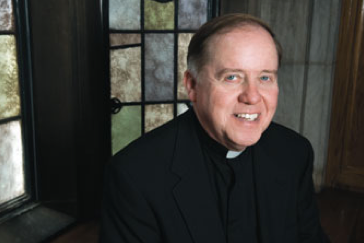
By
Boston College’s Strategic Plan — a broad-based blueprint for the University’s academic, formational and faith initiatives — was the subject of the University Convocation in Robsham Theater on Sept. 7, as the BC leadership offered assessments of the plan on its five-year anniversary.
University President William P. Leahy, SJ, pointed to numerous indicators of progress in fulfilling the seven key facets of the Strategic Plan since it was launched in the fall of 2006. He also outlined what he called “imperatives” for the University in continuing to pursue the objectives of the Strategic Plan, and in meeting other challenges as it approaches its 150th anniversary in 2012-13.
Executive Vice President Patrick Keating and Provost and Dean of Faculties Cutberto Garza also spoke at the convocation, one of the traditional kick-off events for BC’s academic year, and — along with Fr. Leahy — expressed gratitude to administrators, faculty, staff, students, alumni and others in the BC community for their roles in helping BC attain Strategic Plan goals.
Fr. Leahy reviewed the seven “strategic directions” of the plan: leadership in liberal arts education; a model student formation program; research that addresses urgent societal problems; emphasis on natural sciences; leadership in critical professional areas through BC’s professional schools; utilizing its Jesuit and Catholic resources to become an “intellectual and cultural crossroads”; and become the world’s leading Catholic university and theological center.
He identified key points of comparison between 2006 and 2011 that indicate BC’s progress. Among these: increases in the number of AHANA students, the average BC undergraduate SAT score, external research and grant support, financial aid and building space, as well as $800 million in gifts and pledges toward the Light the World campaign’s $1.5 billion goal.
Focusing on the student formation and Jesuit, Catholic aspects of the Strategic Plan, Fr. Leahy noted enhanced cooperation among faculty, deans, administrators and the Student Affairs and Mission and Ministry divisions, the reorganization of the Center for Student Formation and promotion of a positive campus culture — through introduction of late-night programs, student health initiatives and increased opportunities for student retreats, among other developments.
However, he said, BC must continue clarifying the nature and mission of student formation in the BC community, while increasing the involvement of faculty, administrators and staff and achieving the necessary scale in programming and outreach to students.
Similarly, while BC has seen success in its ambition to be the leading Catholic university and theological center — through its reaffiliation with the Weston Jesuit School of Theology, establishment of the Church in the 21st Century Center and publication of The Catholic Intellectual Tradition — its challenges include the need to recruit and educate faculty, administrators and staff supportive of the Jesuit-Catholic mission, while coping with the decline in numbers of Jesuits and tensions within the Catholic Church on governance and other issues.
BC, Fr. Leahy said, should “stay on the course” it has set for investments in faculty, academic and student life programs, financial aid and facilities, but be ready to adapt “as conditions change,” especially given the troubling world economic situation and the stress on higher education financing. He said the University’s Light the World $1.5 billion fundraising campaign must be completed by 2015 and efforts to increase support from alumni, parents and friends must be strengthened.
Fr. Leahy also urged that BC “remain true to our Jesuit, Catholic traditions and beliefs,” which differentiates the University from other institutions.The newly reopened Gasson Hall — regarded as BC’s most iconic building — and its distinctive lighted tower serves as a metaphor for the University’s mission, concluded Fr. Leahy: “We are to be beacons of faith and hope, a light to the world.”
Keating, in his remarks on facilities and finances, also noted the reopening of Gasson — “our signature building” — and drew considerable applause from the audience. The work on Gasson was part of a very active series of campus building projects, he said. These include the construction of Stokes Hall, the transition of University finance and human resource personnel from More Hall to 129 Lake Street on Brighton Campus later this fall, and a proposed new dining facility at the site of Carney Hall.
But these should be viewed as more than a bricks-and-mortar enterprise.
“These buildings, and the other construction we’re planning, will help support academic and student formation goals contained in the Strategic Plan. It’s vital to make that connection.”
Garza discussed academic-related trends and outlooks, such as the continuing academic excellence of BC’s student body as well as its diversity, not only ethnically but geographically and economically as well. Garza also pointed to the transition occurring in the BC faculty: one-third of the faculty has been at BC for five years or less; 41 new faculty were added for this year, and 49 new faculty searches are planned for this year; the proportion of full-time faculty at BC has grown to 85 percent, above the national average of 65 percent. The establishment of new centers and programs — including the Roche Center for Catholic Education, the McGillycuddy-Logue Center for Undergraduate Global Studies and a new PhD in mathematics — has invigorated and strengthened BC’s academic and intellectual offerings, said Garza.Garza predicted that the poor economy and increased competition among peer schools will mean “hard choices” for BC.
However, “tightening our belt is only a defensive tactic, and will not advance our mission,” he added. Concluding the event, Garza said, “BC has every reason to be proud. Even in adversity, this institution has done very, very well.”



